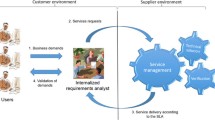Abstract
For a software engineering division of a company, the most important standards are those used for the management of the software engineering projects. While numerous, relevant, de jure, software engineering standards exist, national guidelines, such as the Department of Defense’s Capability Maturity Model, and corporate standards, such as the Microsoft Solutions Framework, exert a significant influence on the marketplace. A study of the existing standards shows significant similarity across them. Case studies of the use of the standards suggest that a major factor in determining the adoption of one standard over another is the environment of the adopter. A company that depends on Microsoft in important business ways is more likely to adopt the Microsoft Solutions Framework. Likewise a company that is a major customer of the Department of Defense may be inclined to use the Capability Maturity Model. The review of software engineering management standards also reveals the dearth of explicit guidance on the roles and processes to use in upper management. Financial process and audit practices influence the application and need for standards. An examination of the operation of a major manufacturing firm (referred to as Company X) shows again the challenge of managing software projects well and the remarkable success that can accrue from a systematic and standard approach across projects.
Similar content being viewed by others
References
Bergin, Thomas and Gibson, Richard (1996). History of Programming Languages, Addison-Wesley Press.
Buchman, Caroline, D. (1996) “Software process improvement at AlliedSignal Aerospace” 29th Hawaii International Conference on System Sciences, ed. H. El-Rewini, IEEE Comput. Soc. Press: Los Alamitos, CA.
CCTA (2000) IT Infrastructure Library Online, 〈http://www.ccta.gov.uk/itil/index.htm〉.
Damgaard (2000) Damgaard and Microsoft: A Strategic Alliance Full of Benefits? 〈http://www.damagaard.com/Damgaard/Damgaard.nsf/All/CORPORATEPartners-Microsoft〉.
DeMarco, David A., Jonathan D. Rabson, and Michael Seebacher (1999) The Human Characteristics for Innovation in the Development of Information Technology? 1st IEEE Conference on Standardisation and Innovation in Information Technology, Aachen, Germany, Sept. 15–17, edited by Kai Jakobs and R Williams, IEEE Press (also available at 〈http://www-i4.informatik.rwth-aachen.de/~jakobs/siit99/Proceedings.html〉).
Dutta, S, Lee, M. A., Van Wassenhove, L. (1998) Adoption levels of software management best practices in European organizations? European Conference on Software Process Improvement, p. 450–456, Meeting Management: Farnham, UK.
Glass, R. L. (1997) Software Runaways. Prentice Hall: NJ.
Gupta, T. and Qasem, A. (1999) IT diffusion: national best practices? Information Resources Management Association International Conference, edited M. Khosrowpour, Publisher Idea Group Publishing: Hershey, PA.
Haley, T. B. Ireland, E. Wojtaszek, D. Nash, and R. Dion, “Raytheon Electronic Systems Experience in Software Process Improvement,” Carnegie Mellon University, Software Engineering Institute, CMU/SEI-95-TR-017, November 1995.
ISACF (1996) COBIT: Control objectives for information and related technology. Information Systems Audit and Control Foundation: Rolling Meadows: IL.
Jones, Capers, and Jones, T. Capers. (1996) Applied Software Measurement: assuring productivity and quality. McGraw Hill: NY.
Microsoft (1999) Microsoft Energizes Damgaard Developers? 〈http://www.microsoft.com/msf/downloads/MSF_at_Damgaard.doc〉.
Microsoft (1999b) Navision Software Development Done Right? 〈http://www.microsoft.com/msf/downloads/MSF_at_Navision.doc〉.
Microsoft (2000) Microsoft Solutions Framework: Turning Technology Projects into Business Solutions? 〈www.microsoft.com/msf/〉.
Monteiro, Eric and Ole Hanseth (1999) Developing corporate infrastructure: implications for international standardization? 1st IEEE Conference on Standardisation and Innovation in Information Technology, Aachen, Germany, Sept. 15–17, edited by Kai Jakobs and R Williams, IEEE Press. (also available at 〈http://www-i4.informatik.rwth-aachen.de/~jakobs/siit99/Proceedings.html〉).
Moore, James and Roy Rada, Organizational Badge Collecting? Communications of the ACM, 39, 8, pp 17–21, August 1996.
Moore, James W (1997) Software Engineering Standards: A User’s Road Map, IEEE Computer Society Press: Los Alamitos, CA.
Munter, Paul (1999), Accounting for Software Development Costs? The CPA Journal, February. http://www.nysscpa.org/cpajournal/1999/0299/Features/F420299H.HTM
Rada, Ray “Sharing standards: IT Skills” Communications of the ACM, 42, 2, pp 21–26, April 1999
Rada, Roy (2000) “Consensus versus Speed” Information Technology Standards and Standardization: A Global Perspective edited by Kai Jakobs, Idea Group Publishing: Hershey, PA, pp 19–34.
SESC (1998) Software Engineering Standards Committee Annual Report, Standards Making Organization of the IEEE Computer Society Technical Council, 〈http://www.computer.org/standards/sesc/annual98.html#AttachmentB〉.
West, Joel (1999) Organizational Decisions for I.T. Standards Adoption: Antecedents and Consequences? 1st IEEE Conference on Standardisation and Innovation in Information Technology, Aachen, Germany, Sept. 15–17, edited by Kai Jakobs and R Williams, IEEE Press (also available at 〈http://www-i4.informatik.rwth-aachen.de/~jakobs/siit99/Proceedings.html〉).
Additional information
Roy Rada earned a B.A. in Psychology from Yale University in 1973, an M.D. in General Medicine from Baylor College of Medicine in 1977, and a Ph.D. in Computer Science from University of Illinois at Urbana in 1980. He has served as Editor of Index Medicus at the National Library of Medicine, Professor of Computer Science at the University of Liverpool, Boeing Distinguished Professor of Software Engineering at Washington State University, and now Professor of Information Systems at the University of Maryland at Baltimore County. Roy is a Fellow of the ACM and has authored 10 books and co-authored 150 journal papers.
John S. Craparo spent 10 years at GE Capital Services, where he served as the SeniorVice President & Chief Information Officer for three business units involved in equity investment, leveraged buyout, merger and acquisition, and structured project finance activities. He was also the CIO for corporate systems and global finance operations. He holds a bachelors degree from Iona College and a Master of Science in Technology Management from Polytechnic University (Brooklyn Poly). John sits on the CSIS advisory board of Pace University, where he served as an adjunct Associate Professor of Information Systems for 11 years. John sits on the editorial board of Continuing Professional Development. John has authored several commercial software programs, including a popular telecommunications circuit optimization tool.
Rights and permissions
About this article
Cite this article
Rada, R., Craparo, J.S. Standardizing management of software engineering projects. Know Techn Pol 14, 67–77 (2001). https://doi.org/10.1007/PL00022276
Issue Date:
DOI: https://doi.org/10.1007/PL00022276




